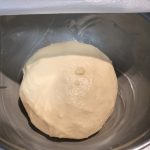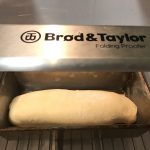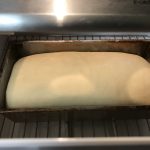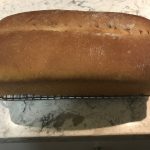
Challah
This bread is very easy to make and shape since, in this case, we are not braiding it. Just shape as for a regular sandwich loaf, proof in the pan until just to the top and bake. And, the whole house will smell grand for hours.
Ingredients
Challah ingredients
- 313 g Bread flour 11 oz
- 71 g Cold unsalted butter 2.5 oz
- 40 g Sugar
- 6 g Salt
- 7 g Instant yeast
- 1 each Egg
- 141 g Water 5 oz
Instructions
Mix the dough
-
Scale the flour, yeast, salt, butter and sugar into the bowl of a stand mixer.
-
Mix the egg and water to combine. Add to the dry ingredients and mix on low speed for 4 minutes.
-
After 4 minutes on low are finished, mix on medium for 4 additional minutes.
-
When the dough is done, remove and shape into a round, pinching the bottom together with the palm of your hand.
-
Place the finished dough, seam side down, in a buttered bowl. Cover and allow to ferment 30 minutes.

-
After 30 minutes has passed, turn the dough over and pull the edges of the dough to the center, working around the edge about a dozen times.
Turn the dough back onto the seam. Cover the bowl and ferment an additional 30 minutes.
-
At the end of the 30 minutes, remove the dough to a floured work surface and shape for a sandwich loaf.

-
Place the shaped dough into a buttered metal bread pan and proof until the dough is at least double in height.

-
Bake at 350°F for 35 minutes or until it is determined to be done, either with the thump test or a thermometer which reads 180°F.

Recipe Notes
Challah is an enriched dough which means it has egg and/or butter added to it. Enriched breads can be trickier than regular breads for determining doneness, which is the reason for a thermometer. Better to be sure than not, for once the dough has cooled, it cannot be baked more.
The two periods of 30 minute fermenting should be followed. Allowing the dough to ferment too long reduces the final height of the loaf. Better to let all the yeast energy prove the dough in the pan so you get a higher loaf.